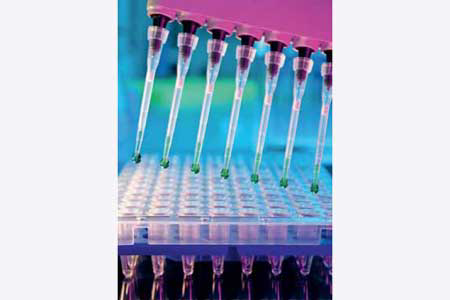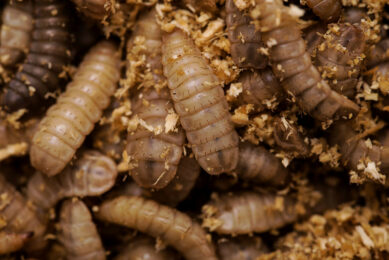Precise detection of ruminant proteins in feeds

Tentative steps are being made to allow processed animal proteins back in feeds for monogastrics. It has to be assured however, that these do not contain any ruminant proteins. TNO Triskelion has developed a real time PCR-test with a high accuracy to achieve this. By: Gert van Duijn, Jonne Mensinga and Monique Raats, TNO Triskelion BV, The Netherlands
For many years already the BSE crisis has had an enormous political and economic impact. Since 2001 a complete ban for the use of processed animal proteins has been instituted by the European Commission in order to maintain a high level of consumer protection. However, due to the reducing number of animals suffering from TSE during the last decade, the EU commission enabled a possible partial lifting of the feed ban. This adaptation is described in the TSE Road map 2 (see next page) including a series of strict rules such as prohibition of the use of Processed Animal Proteins (PAP) derived from ruminants , as well as continuation of the ban of intra-species recycling of these PAP’s.
Implementation of this adapted strategy needs reliable and validated analytical testing procedures in order to determine the species-origin of these animal by-products. Several techniques based upon microscopy and spectroscopy have been considered for this purpose. Also, in order to allow a fast screening procedure on PAP production plants, rapid protein-specifi c tests based upon ELISA technology have been developed. By now, analytical procedures enabling the detection of DNA promise to be the most powerful. Within TNO Triskelion various real-time PCR (Polymerase Chain Reaction) methods have been developed for the specifi c detection and discrimination of DNA derived from several species such as ruminants (inclusive cattle, goat and sheep), porcine and poultry. These methods have even been proven to be robust for analysis on PAP’s which, as a rule, experienced a treatment for 20 min. at 133°C and 3 bar. Further, in order to exclude the possibility of negative matrix effects, these methods were validated with a wide variety of samples including various types of meat and bone meal from various sources. Also the applicability of the RT-PCR methods was shown for the traceability of different PAP’s in feed samples.
Method assessment
In a next phase, the ruminant-DNA specifi c RT-PCR method as developed within TNO Triskelion BV was further assessed in cooperation with the European Union Reference Laboratory for Animal Protein in feeding stuffs (EURLAP). Besides a deep evaluation of the method with respect to specifi city and sensitivity towards DNA from a wide variety of animals, the method was tested for its robustness, also including the use of various types of laboratoryequipment and reagents.
As a consequence of their positive experiences the EURL-AP decided to continue and organise an inter-laboratory validation study. Participants in this study which took place in the fi rst quarter of 2012 were 12 independent European institutes. Most of these laboratories had very good results with an overall rate of false positive results below 5 %. In addition, in this validation study a feed sample with a content of only 0.1 % of ruminant PAP was scored as positive for ruminant DNA with a confi dence above 99%. From these studies it was concluded that the TNO Triskelion method is fi t for the purpose of the detection of 0.1 % of ruminant PAP’s in feed.
This conclusion will be of crucial interest for maintenance of the prerequisites as described in EU regulation documents with regard to partial lifting of the feed ban. Also this method could allow the possible regulatory decision on a threshold value for PAP’s in feed above a value of 0.1 %. As an extension it is of great interest to perform these types of RT-PCR experiments under high quality standards. For this reason TNO Triskelion is attempting to warrant their services under high quality standards.
TSE ROAD MAP 2
By Dick Ziggers
In order to reintroduce processed animal proteins (PAP) derived from nonruminants into the feed chain the TSE Road map 2 was presented to the European Commission. The Communication was adopted on 16 July 2010 and complemented by a Commission Staff Working Document (CSWD) with Annexes. The road map is a refl ection paper on future amendments of the TSE measures for the period 2010-2015 with the goal to review the TSE measures while assuring a high level of food safety. The whole development will be carried out stepwise and has a science based approach (a.o. European Food Safety Authority, EFSA). Different topics are covered such as SRM removal, feed ban, BSE surveillance, and TSE measures in small ruminants.
The feed ban is the most important issue for the feed industry, which involves the reintroduction of PAP into the feed chain. The current feed ban entails a wide suspension on the use of PAP in feed for farmed animals since 2001. There are some exceptions: i.e. fi shmeal for non-ruminants. A heavy issue is also the “zero tolerance” rule (with the exception: environmental contamination). Animal by-product regulations require that PAP is produced from by-products derived from animals fi t for human consumption (CAT 3) and that PAP traceability can be ensured. EFSA already published some opinions on PAP use. In 2007 it concluded “risk of transmission of BSE from non ruminants to non ruminants is negligible provided cross-contamination with ruminant material and cannibalism is prevented.” In 2010 a quantitative risk assessment concluded that the “re-use of PAP would lead to less than one (0.2) additional BSE infected animal per year in EU, which is not suffi cient enough to lead to a new epidemic.”
The envisaged measures for lifting the current feed ban focus on lifting feed ban provisions for non-ruminants (pigs, poultry, fi sh) while avoiding cannibalism. Lifting feed ban provisions for ruminants is not envisaged. To enable a relaxation of the ban control tools (PCR methods) need to become available and feed processors need to install dedicated production lines to avoid cross contamination.
Political aspects
It is not only a technical issue, which would be the basis for ending the feed ban. Technical problems can be solved in time. Far more the political will to end the ban is an obstacle. The European Council published its conclusions on 29 November 2010 and the European Parliament presented a resolution on 6 July 2011, where it supported the Commission’s intention to lift the feed ban on PAP from nonruminants provided that there will be no intraspecies recycling (cannibalism), that it will not be applicable to herbivores, that there is a strict separation of production channels and that PCR methods are in place.
To answer to the Commission’s proposal 3 Working Groups with member states since April 2011 have been put in place and 2 consultations of stakeholders in 2011 have taken place.
The Commission’s proposal aims to continue the ban on ruminants proteins in the feed chain and re-authorise the use of PAP from non-ruminants into pig, poultry and fish feed. Furthermore to provide some guarantees that risk of cross-contamination is minimised as much as possible through the “single species” approach via a strict spatial segregation of the production lines and a control system based on PCR tests at each step of the production chain and strict labelling requirements. No tolerance level has been foreseen because no quantitative test was available but that could change quite soon now a test like the described TNO Triskelion becomes available.
From an EU perspective adoption was foreseen in the first half of 2012 and then the proposal could enter into force in the second half of 2012, if PCR tests are available. Then PAP could be reintroduced in the feed chain, however this estimation appeared to be too optimistic. There are still several challenges to conquer. A controls organisation has to be set up, the industry needs to make investments for separate production lines and effective communication towards consumers needs to take place. The most difficult part will be political. Recently a proposal to use PAP in fish feed was backed by a majority of EU member states – but not all. Three governments voted in favour of a European Commission proposal to end the ban at a meeting of the Standing Committee on the Food Chain and Animal Health in July.











